As I venture into the world of anthropology for the first time, I want to start with a basic understanding of what it entails and the different components that make up anthropology. I am mostly interested in biological and cultural anthropology, but learning more about the field as a whole will create a clearer picture of the field for me. Therefore, my first blog post is dedicated to an overview of what anthropology is, different types of anthropology, and the jobs that can be gotten with a major in each subfield.
Overview
The question I started researching first was basic: What is anthropology? I looked at scholarly articles and different websites, but I realized that, while learning through reading articles may help some people, what I needed was visuals and easily understandable language. So I turned to the best thing I could think of: Youtube. A basic search of anthropology pulled up numerous videos about majoring in anthropology in college and the vast variety of different fields of anthropology, plus an interesting song by Charlie Parker. These search results only led to more questions, so I started simple and watched videos that gave me short overviews of anthropology (with a brief break to listen to Charlie Parker). Then, I read through a few college’s descriptions of anthropology as a major to get an idea of it in a school setting.

Anthropology can be broken down into two Greek roots: anthrop (or anthropos), which means “human”, and ology, which means “the study of”. So, in its purest form, anthropology is the study of humans: their similarities and differences. There are four main subfields of anthropology: biological, cultural, linguistic, and archaeology. Combining these four can help anthropologists see how humans have changed over time, whether it be evolutionarily, culturally, historically, or linguistically. Using this knowledge, anthropologists can try to predict future trends or better understand the journey humanity has made so far.
An important word to keep in mind when learning about anthropology is holism. Anthropologists use a holistic approach to their studies by considering every factor that could affect the phenomena being studied. An example pulled from the book Explorations: An Open Invitation to Biological Anthropology, first edition states “A cultural anthropologist studying marriage in a small village in India would not only consider local gender norms but also family networks, laws regarding marriage, religious rules, and economic factors. All of these aspects can influence marital practices in a given context”. When reading about these different subfields with examples of studies that can be done within them, keep in mind this holistic approach that will be present. It makes these studies that much more impressive when you realize the magnitude of research that goes into them.
Biological Anthropology
Biological anthropology mostly looks at the evolution of humans and the biological variations that have formed. However, there is a vast range of research that can be performed under the umbrella of biological anthropology, so classifying it with a simple definition is tough. To study evolution, anthropologists either focus on primates or human remains. Studying variation involves observing humans now, whether it be adaptations, genetics in different populations, or overall health from several lifestyle factors. This short list in no way encompasses everything a biological anthropologist can do; it is just a few introductory points.

Biological anthropologists find their work taking them into the field quite often. Those studying primates (primatologists) go into the wild to closely observe their behaviors. This could involve a study in which an anthropologist is trying to compare the social relationships of a primate to human society. They can also work in a zoology department. Those who combine archaeology and biology (human paleontologists) go around the world, studying fossils to determine the behavior of humans in the past, or they could work at museums of natural history. Studying human biology today could involve researching the evolution of different races, or the circumstances behind different allergies that some populations are more prone to. Biological anthropologists can even go into law enforcement as forensics experts. The varied jobs that a biological anthropology degree can get you is part of the reason why it is such a popular subfield of anthropology.
Cultural Anthropology
Cultural anthropology focuses on cultural variations in humans, and how it shapes their lives and the world. These anthropologists must let go of their own biases and judgments to immerse themselves in different cultures so they can get a complete picture of that culture. This is a practice known as cultural relativism. In doing so, they must temporarily shut out their own culture to effectively view a culture from a fresh perspective. Cultural anthropologists study everything, from art and music to religion and politics. To understand a culture completely, they use the concept of holism. Many cultural anthropologists may go live in the place they are studying to better understand the culture present there. A famous example of an experiment in cultural anthropology was performed by Margaret Mead in 1928. She went to Samoa to live there for a few months, researching their teens. This was because there was a “rebellious teenager” phase that the US was going through and she wanted to see if it held up elsewhere. Her findings said differently, showing that the Samoan teens were calm and well-behaved. After she came back, she published it in a book, criticizing American parents for being restrictive and conservative parents.

Cultural anthropologists work mostly in the field as they research. They must be a part of the culture they are studying temporarily, so they travel around the world through their research. This is called ethnographic research. However, research isn’t the only option. They could become historians because of their schooling as a general anthropologist, or even become an interpreter. Though they are not linguistic anthropologists, studying different cultures and doing research around the globe opens up opportunities to learn different languages and skills. This branch of anthropology is one of the most general, and many subfields branch off of it, such as medical, legal, and business anthropology.
Archaeology
Archaeology is probably one of the most well known of the subfields of anthropology. It is very connected to human paleontology, however archeologists mostly work with materials, while paleontologists work with fossils. Archaeology is the study of human history and prehistory. Just as a side note, prehistory is before writing was invented, and history is between the invention of writing and present day. Archaeologists can do anything from analyzing old artifacts from ancient civilizations or excavating ancient cities.

I used to think that archaeologists had the coolest job ever: finding dinosaur fossils. (I’ve since realized paleontology is actually the field where dinosaurs can be found.) However, as disappointed as I was to learn that, archaeologists actually do have an interesting line of work. Of course, the part of the job that everyone knows about is the excavation, but there is so much to be done after something is discovered. They must research that artifact and use it to learn more about our ancestors. They are also responsible for the preservation of historical sites, such as Petra. There is a misconception that archaeologists travel all the time, but actually, most aren’t on the field. They work in museums, schools, and for the government, so while it may not be all traveling, there are plenty of job opportunities.
Linguistic Anthropology
Linguistic anthropology is the study of language and how it affects different cultures and human socialization. I had never heard of this branch of anthropology, so this was both the most fun and the hardest to learn about. Language is used to communicate ideas, bring about change, and illustrate beliefs. Linguistic anthropologists study how differences in language shape thought and communication. For example, there is a word in Spanish and Portuguese, sobremesa, that means relaxing and chatting at the table after a meal has finished. It’s really untranslatable to English, and linguistic anthropologists could look at it to see cultural differences between English speakers and Spanish/Portuguese speakers. It is thought that those cultures are less rushed to go about their day after a meal, so it is a more relaxed affair. These anthropologists also study how languages came about and the changes that have occurred in it over time. Slang constantly keeps changing throughout generations, and anthropologists study those types of changes to see differences in these generations. They could also look at how languages could bring to light inequalities in certain cultures.

Linguistic Anthropologists can have field jobs, though many do end up working as professors. Because of their language skills and studies in social interaction, they can end up also working on social media teams or in public relations. They can even get asked to create a new language. In fact, many fantasy movies and shows have asked linguists and linguistic anthropologists to create languages for them, such as Star Trek and Superman. While it may not be a very well known field, it is a major part of anthropology that looks at something everyone can relate to: language.
The End!
After talking about these four branches, I realized there is one “branch” I did not mention. It is called applied anthropology, and it is not truly a branch, but instead more of an umbrella term. It is just the practical application of every field of anthropology; any research done to solve a real-world problem would be classified under this umbrella.
Thank you for reading this post, and I hope you come back to read more!
My Research
These are some websites I read and videos I watched to write this blog.
https://www.youtube.com/watchv=3iB7lvdjhzE
https://bioanth.org/career/career-biological-anthropology/
Introduction to Biological Anthropology